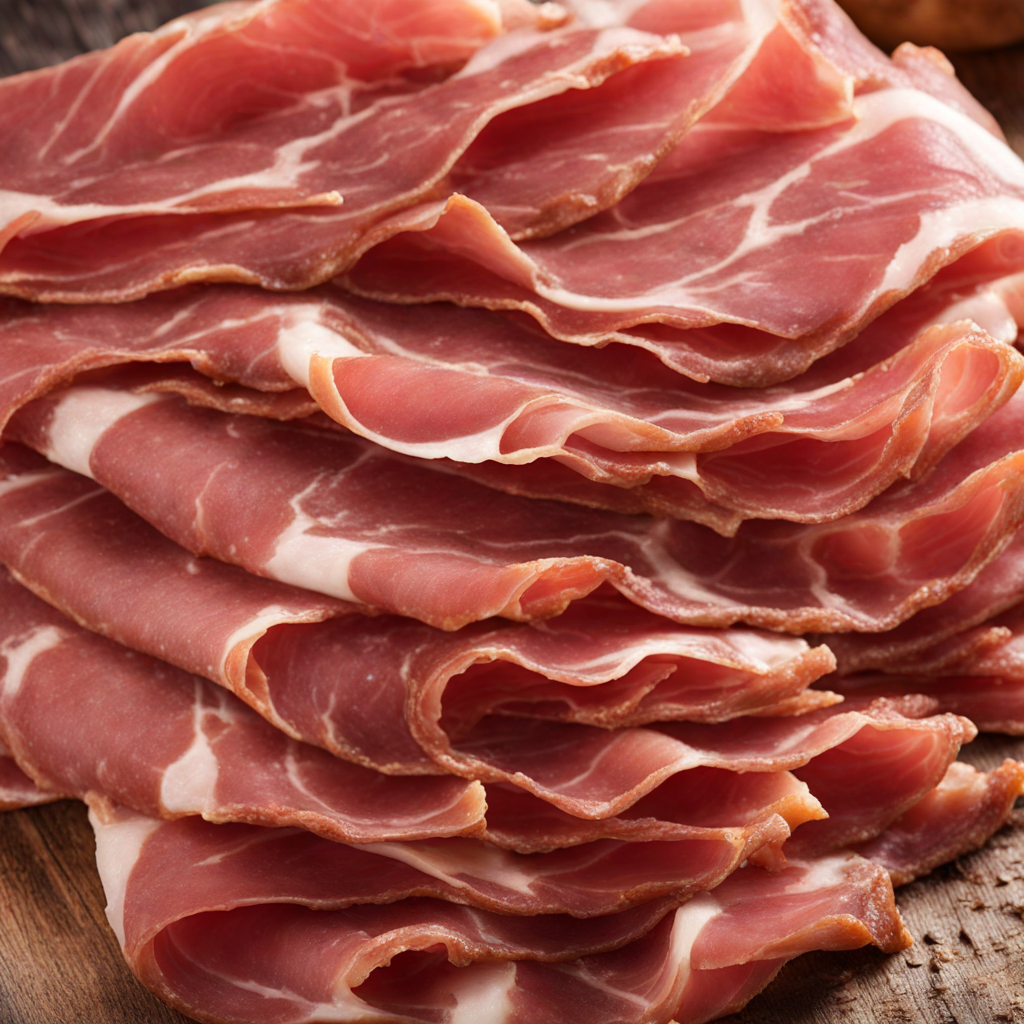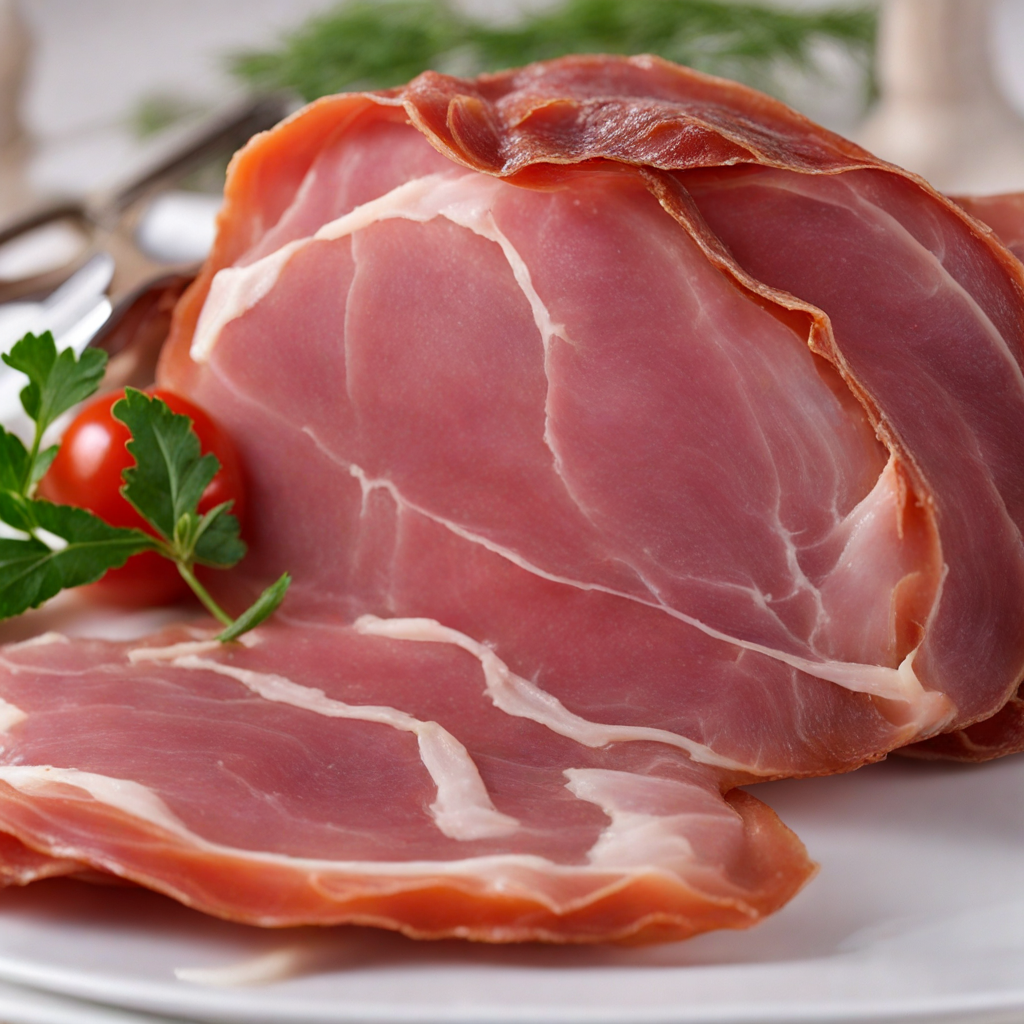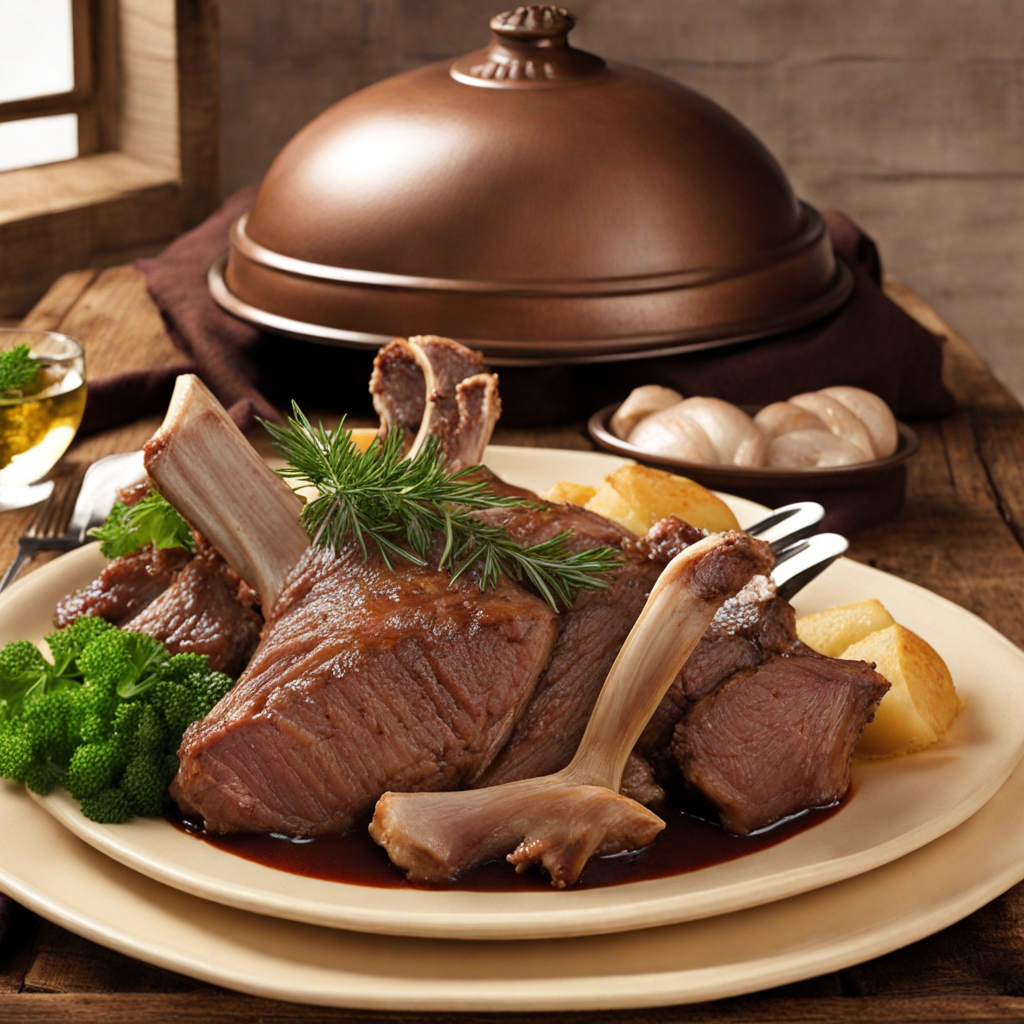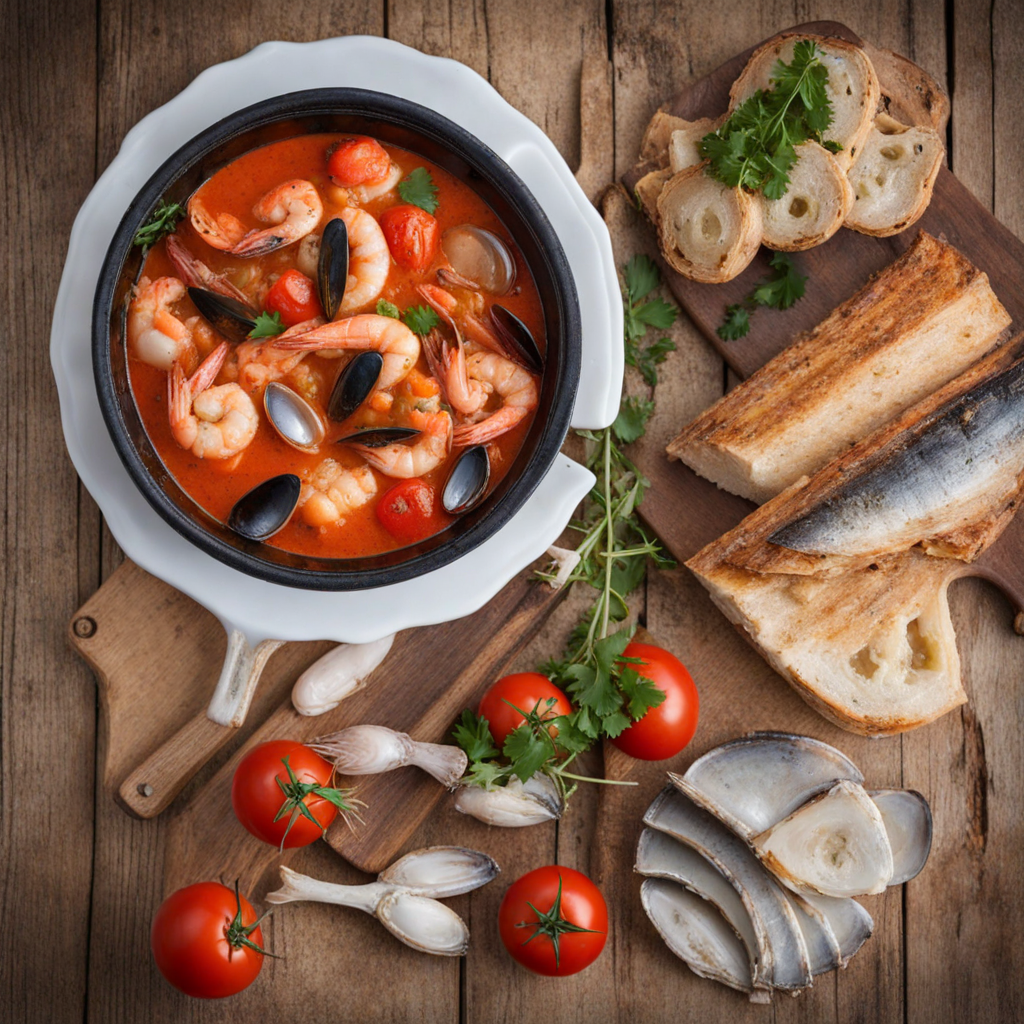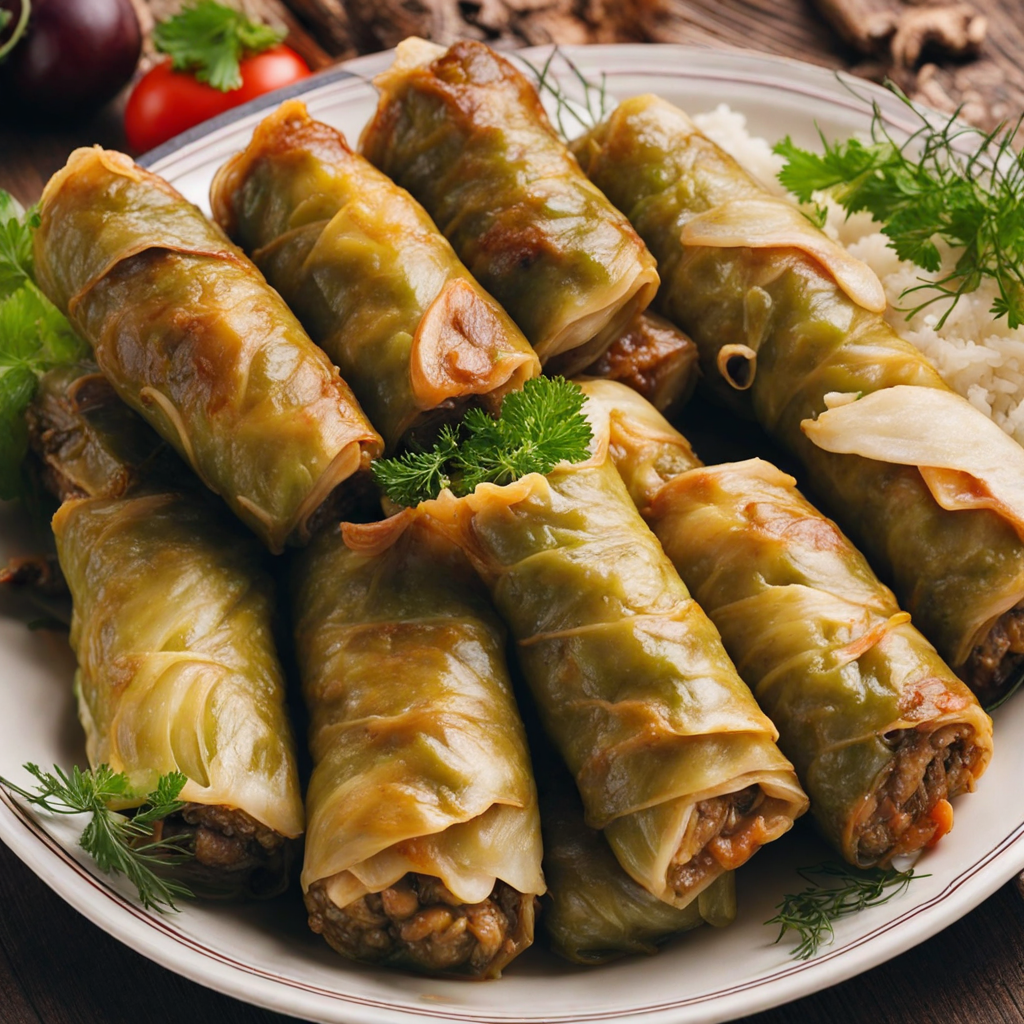Njeguški pršut
Njeguški pršut is a traditional Montenegrin delicacy that embodies the rich flavors and cultural heritage of the region. This dry-cured ham is crafted from the hind legs of pigs, which are carefully selected for their quality. The process begins with salting the meat, often using a blend of sea salt and spices, and then it is left to cure in a cool, dry environment. The unique microclimate of the Njeguši village, nestled in the mountains, plays a crucial role in developing the ham's distinct flavor profile, allowing it to dry slowly and naturally, which enhances its taste and texture. What sets Njeguški pršut apart is its exceptional taste, characterized by a rich, savory profile with hints of smokiness. The meat is typically aged for several months, allowing the flavors to deepen and mature. When sliced thin, it reveals a beautiful marbling of fat, which contributes to its tenderness and melt-in-your-mouth quality. The aroma is inviting, with subtle notes of herbs and spices that tantalize the senses, making it a perfect accompaniment to a variety of dishes or enjoyed on its own. This delightful ham is often served as part of a charcuterie board, paired with local cheeses, olives, and crusty bread, creating a simple yet indulgent experience. It can also be incorporated into salads, pasta dishes, or wrapped around fresh fruits, combining the savory with the sweet for a delightful contrast. Njeguški pršut is not just food; it's a taste of Montenegrin tradition, perfect for those looking to explore new culinary horizons and savor the authentic flavors of the Balkans.
How It Became This Dish
The History of Његушки пршут: A Culinary Treasure from Montenegro Nestled in the heart of the Balkans, Montenegro boasts a rich tapestry of culture, history, and cuisine. Among its culinary gems, one item stands out: Његушки пршут (Njeguški pršut), a dry-cured ham that embodies the essence of Montenegrin tradition and craftsmanship. This delicacy not only tantalizes the taste buds but also weaves a narrative of the region's agricultural practices, historical influences, and communal identity. Origins: A Tradition Rooted in Geography The origins of Његушки пршут can be traced back to the village of Njeguši, located in the mountainous region of Montenegro, near the capital city of Podgorica. The unique geography of this area—characterized by its high altitude, fresh mountain air, and proximity to the Adriatic Sea—provides an ideal environment for curing meats. The cool, dry climate contributes to the slow maturation process, allowing the flavors to develop naturally. Historically, the practice of curing meat in this manner dates back centuries, influenced by various cultures that traversed the Balkans. The Ottomans, for example, introduced advanced culinary techniques that blended with local customs. However, it was the Montenegrin shepherds and farmers who refined the process, relying on traditional methods passed down through generations. The use of natural smoking, salt, and herbs became central to the identity of Njeguški pršut. Cultural Significance: A Symbol of Montenegrin Identity Njeguški pršut is more than just a food item; it is a symbol of Montenegrin identity and pride. Within the local culture, this cured ham is often associated with festivities, family gatherings, and communal meals. It is typically served as an appetizer, sliced thinly and accompanied by local cheeses, olives, and homemade bread—an embodiment of the Montenegrin way of life that emphasizes hospitality and communal sharing. The ham is also an integral part of traditional celebrations, such as weddings and religious holidays. Its preparation often becomes a communal event, where families gather to share techniques and stories, reinforcing bonds and passing down culinary knowledge. Such gatherings highlight the importance of food in fostering connection and community. The Craft of Curing: Techniques and Ingredients The artisanal production of Njeguški pršut involves a meticulous process that combines both art and science. The primary ingredient is pork, typically from the rear leg of the pig, which is carefully selected for its marbling and quality. The process begins with salting the meat, where coarse sea salt is applied generously. This step is crucial as it draws out moisture, aiding in preservation while enhancing flavor. After salting, the ham is rinsed and then coated with a mixture of garlic, pepper, and other herbs, such as bay leaves and thyme. This stage not only infuses the meat with aromatic flavors but also contributes to the development of its distinctive taste. The next phase involves hanging the ham in a cool, airy space, allowing it to dry naturally. This aging process can take anywhere from several months to over a year, during which the ham undergoes fermentation and flavor deepening. A defining characteristic of Njeguški pršut is its smoking, traditionally done using wood from local trees like beech or oak. The smoke permeates the meat, adding complexity and depth to its flavor profile. This practice, along with the unique climatic conditions of the Njeguši region, differentiates Njeguški pršut from other cured hams around the world, such as Spanish Jamón Ibérico or Italian Prosciutto di Parma. Evolution Over Time: Traditional Meets Modern As Montenegro has evolved, so has the production of Njeguški pršut. While traditional methods remain at the core of its preparation, contemporary influences have also made their mark. The rise of tourism in Montenegro has brought greater attention to local delicacies, leading to a heightened demand for authentic products. As a result, some producers have begun to adopt more industrial methods to meet this demand, which has sparked a dialogue about preserving traditional practices. Despite modern pressures, many artisanal producers remain committed to traditional techniques. Organizations and local cooperatives have emerged, dedicated to protecting the authenticity of Njeguški pršut. These groups advocate for sustainable practices and promote the importance of heritage in culinary production. Additionally, the establishment of quality control standards ensures that producers maintain the high quality and authenticity of their products. Recognition and Global Reach In recent years, Njeguški pršut has garnered recognition beyond Montenegro's borders. It has been featured at culinary festivals and food fairs across Europe, celebrated for its rich flavor and unique production process. The significance of Njeguški pršut has led to its inclusion in Montenegrin national cuisine, and it has become a point of pride for locals eager to share their culinary heritage with the world. The ham's reputation has also contributed to a growing interest in Montenegrin cuisine as a whole. Food enthusiasts and travelers are increasingly drawn to the flavors and traditions of the region, seeking out authentic experiences that connect them to the local culture. This tourism trend has spurred a revival of interest in other traditional Montenegrin foods, fostering a renaissance of local culinary practices. Conclusion: A Culinary Legacy Njeguški pršut is more than just a delicacy; it is a testament to Montenegro's rich cultural heritage and the resilience of its people. From its humble origins in a small mountain village to its recognition as a symbol of national pride, this cured ham embodies the stories, traditions, and communal spirit of Montenegrin life. As the world continues to embrace local and artisanal foods, Njeguški pršut stands as a shining example of how culinary practices can preserve history while adapting to modern influences. In every slice of this exquisite ham lies a narrative of land, labor, and love—elements that are integral to the cultural identity of Montenegro and its people. As we savor its rich flavors, we are reminded of the importance of food as a bridge connecting us to our past, our communities, and each other.
You may like
Discover local flavors from Montenegro


